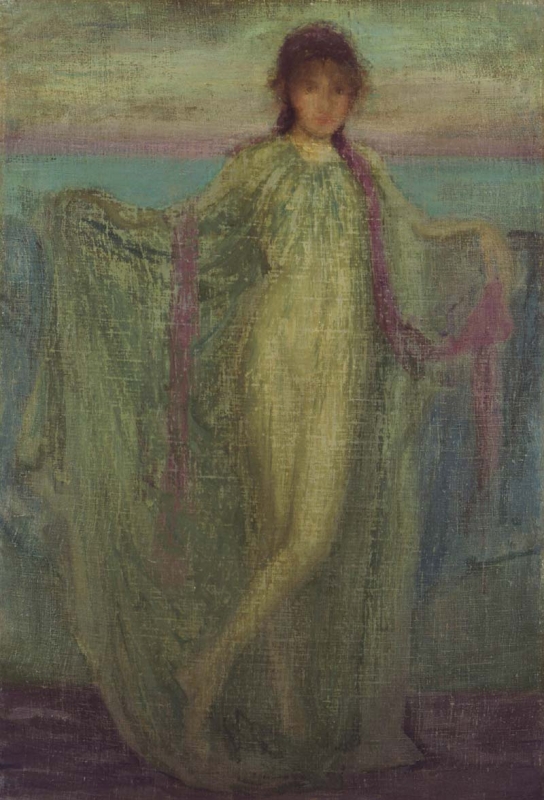Composition
The composition of a small oil painting known as Sketch for 'Annabel Lee' [YMSM 080] is similar to that of Annabel Lee, but it is not certain if it came first or was inspired by it.
Technique
Annabel Lee is on a very fine plain tabby-weave canvas, very slubby and loosely woven (like muslin rather than linen), trimmed and paste-lined with a more textured fine weave canvas. Cusping of the canvas edges shows that it has lost at least 3 cm from the top and bottom edges. This would have made a considerable difference to the position of the figure, which would have had more space above the head. There is a thin priming layer including silica, lead white, chalk and earth pigments. The imprimatura is a pinkish brown colour, and analysis shows that it includes lead white, chalk, bone black and natural earth pigments. There is no sign of underdrawing. It appears to have been painted from the start as a draped, not a nude, figure. 1
Early sittings were interrupted by the illness of the first model, in 1871. In 1877, several years after he had commissioned this oil, William Graham wrote 'If my recollection does not mislead me it was quite sufficiently attractive in the state I bought it in, to be a pleasant addition to my collection.' 2 However, Whistler replied, 'Curiously unable to satisfy myself I have over and over again attempted to complete the work and only by degrees brought about its destruction.' 3 It was presumably in such a rubbed down state by 1879 that it was exempted from Whistler's bankruptcy sales, and the canvas was returned to him later – possibly many years later.
According to Harold Wright (1885-1961), it was rubbed down for subsequent repainting around 1900. 4
Visual evidence confirms that the painting was partially reworked. At both the left and right edges, the paint runs over the edge that had been trimmed for lining, suggesting that it might have been lined for Whistler, before he reworked it. 5 The paint on the head is smoother than elsewhere and the paint looks of a different quality, showing that the face was reworked. Greenish-blue streaks radiating from the neck run over the pink scarf and are also evidence of later working. Sky, horizon and water were painted partly over the reworked head.
Prussian blue was used for the background and the water. The pink horizon includes madder, non-fluorescent red lake, ultramarine, bone black, lead white, and a lot of wet-in-wet working. 6
Although the entire painting has been thoroughly rubbed down, it still glows with rainbow colours, and the face is delicately and softly painted.
Conservation History
The painting was largely rubbed down – at times, right down to the canvas – and the remaining paint is abraded and very thin indeed. However, the paint is in a generally stable condition, although the canvas is weak at the edges. 7
It was bequeathed by Miss R. Birnie Philip to the University of Glasgow with the specific instruction that it should not be restored.
Frame
Flat Whistler frame, probably dating from the 1870s, 105.5 x 81.5 x 5.2cm. This painting was never displayed during Whistler's lifetime, so it could have remained unframed, and been framed eventually with a frame of the right size from the studio.
Notes:
1: Reports by Clare Meredith, 30 April 2001, Hunterian files; Dr (now Professor) Erma Hermens, University of Glasgow, 2003; Professor Joyce H. Townsend, Tate Britain, April 2017.
2: Graham to Whistler, 23 July 1877, GUW #01783.
3: Whistler to W. Graham, [23/30 July 1877], GUW #01784.
4: Label on verso written by H. Wright, initialled by Miss R. Birnie Philip.
5: Information from Dr Erma Hermens, University of Glasgow, 2003 (now Professor Hermens, Rijksmuseum).
6: Technical analysis carried out at the Natural History Museum EM Unit, London, for Professor Townsend; Examination report, April 2017, op. cit.
7: Meredith, 30 April 2001, op. cit.
Last updated: 1st November 2020 by Margaret








